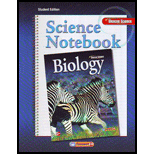
To compare:
The terms in the given table by defining them.
Introduction:
Populations of species are described by density, spatial distribution and growth rate. There are some limiting factors also that keep population from growing indefinitely. They tends to stabilize near the
Answer to Problem 3MI
| Population density- It refers to the number of organisms per unit area. | Dispersion- It refers to the pattern of spacing of a population within an area. |
| Density- independent factor- It refers to any factor in the environment that does not depend on the number of members in a population per unit area. | Density- dependent factor- It refers to any factor in the environment that depends on the number of members in a population per unit area. |
| Emigration- The number of individuals moving away from a population. | Immigration- The number of individuals moving into a population. |
| Carrying capacity- Itis the maximum number of individuals in a species that an environment can support for a long term. | |
Explanation of Solution
Population density- It refers to the number of organisms per unit area.
Dispersion- It refers to the pattern of spacing of a population within an area.There are three main types of dispersion- uniform, random and clumped. One important primary factor in the pattern of dispersion for all organisms is the availability of resources such as food. The limiting factors for spatial distribution are either density- independent factors or density- dependent factors. These factors prevent a population from growing indefinitely.
Density- independent factor- It refers to any factor in the environment that does not depend on the number of members in a population per unit area.Density- independent factors are abiotic and include natural phenomena such as weather events. These include flooding, extreme heat or cold, tornadoes and hurricanes. Human activities like air, water and land pollution can also limit populations.
Density- dependent factor- It refers to any factor in the environment that depends on the number of members in a population per unit area.Density- dependent factors are often biotic such as predation, disease, parasites and competition.
Population growth rate- It is defined as the speed at which a population grows. Important features to keep in mind while calculating growth rate are natality and fatality rate. Natality of a population is the birth rate or number of individuals born in a given period of time. Mortality is the number of deaths that occur in a population over a given period of time.
Emigration- The number of individuals moving away from a population.
Immigration- The number of individuals moving into a population. In most instances emigration and immigration are equal.
Carrying capacity- Itis the maximum number of individuals in a species that an environment can support for a long term.It is limited by the energy, water, oxygen and the nutrients available. The number of individual increase till the carrying capacity is reached. Species of organisms vary in the number of births per reproduction cycle, in the age that reproduction begins and in the life span of organisms. Plants and animals are placed in groups based on their reproductive factors.
Additional Science Textbook Solutions
Human Biology: Concepts and Current Issues
Laboratory Experiments in Microbiology (12th Edition) (What's New in Microbiology)
Campbell Biology in Focus (2nd Edition)
Brock Biology of Microorganisms (15th Edition)
Human Physiology: An Integrated Approach (8th Edition)
Anatomy & Physiology (6th Edition)
 Human Anatomy & Physiology (11th Edition)BiologyISBN:9780134580999Author:Elaine N. Marieb, Katja N. HoehnPublisher:PEARSON
Human Anatomy & Physiology (11th Edition)BiologyISBN:9780134580999Author:Elaine N. Marieb, Katja N. HoehnPublisher:PEARSON Biology 2eBiologyISBN:9781947172517Author:Matthew Douglas, Jung Choi, Mary Ann ClarkPublisher:OpenStax
Biology 2eBiologyISBN:9781947172517Author:Matthew Douglas, Jung Choi, Mary Ann ClarkPublisher:OpenStax Anatomy & PhysiologyBiologyISBN:9781259398629Author:McKinley, Michael P., O'loughlin, Valerie Dean, Bidle, Theresa StouterPublisher:Mcgraw Hill Education,
Anatomy & PhysiologyBiologyISBN:9781259398629Author:McKinley, Michael P., O'loughlin, Valerie Dean, Bidle, Theresa StouterPublisher:Mcgraw Hill Education, Molecular Biology of the Cell (Sixth Edition)BiologyISBN:9780815344322Author:Bruce Alberts, Alexander D. Johnson, Julian Lewis, David Morgan, Martin Raff, Keith Roberts, Peter WalterPublisher:W. W. Norton & Company
Molecular Biology of the Cell (Sixth Edition)BiologyISBN:9780815344322Author:Bruce Alberts, Alexander D. Johnson, Julian Lewis, David Morgan, Martin Raff, Keith Roberts, Peter WalterPublisher:W. W. Norton & Company Laboratory Manual For Human Anatomy & PhysiologyBiologyISBN:9781260159363Author:Martin, Terry R., Prentice-craver, CynthiaPublisher:McGraw-Hill Publishing Co.
Laboratory Manual For Human Anatomy & PhysiologyBiologyISBN:9781260159363Author:Martin, Terry R., Prentice-craver, CynthiaPublisher:McGraw-Hill Publishing Co. Inquiry Into Life (16th Edition)BiologyISBN:9781260231700Author:Sylvia S. Mader, Michael WindelspechtPublisher:McGraw Hill Education
Inquiry Into Life (16th Edition)BiologyISBN:9781260231700Author:Sylvia S. Mader, Michael WindelspechtPublisher:McGraw Hill Education





